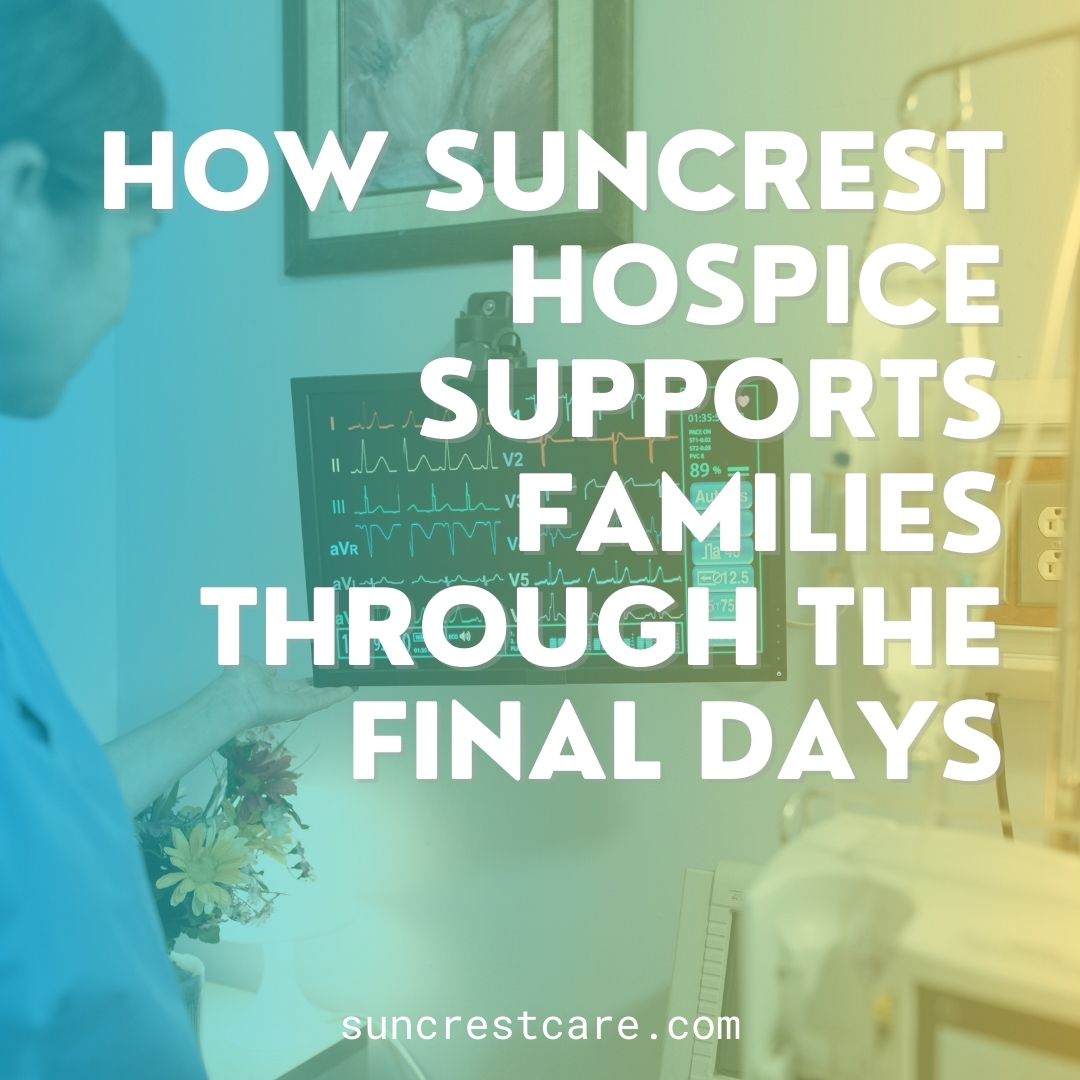Loved ones of hospice patients understandably want to be present for the death of their loved one, but determining exactly when this will be can be challenging. Changes such as body temperature when dying are part of what families often watch for during this time. The hospice nurses at Suncrest Home Health and Hospice work with families and friends of patients to help them understand what is happening and what to expect in hospice care.
Sometimes friends and family members of hospice patients are afraid to go home to shower or eat because they fear their loved one might die while they are gone. While it is not possible to predict time of death with great accuracy, body temperature is one of several signs that death is approaching:
What Happens to Body Temperature When Dying?
Common Changes in Body Temperature
As a person nears the end of life, their body temperature often begins to drop. This is a normal part of the dying process. The body starts to conserve energy for vital organs, and blood flow to the skin and extremities slows. As a result, hands, feet, and sometimes the face may feel cool or cold to the touch.
Body Temperature When Dying
Many families notice that their loved one’s body feels cooler during the last days or hours. Some describe the skin as clammy, while others see a slight color change, such as the skin becoming pale or bluish. These changes usually mean the body is preparing for death.

A Natural Part of End-of-Life Care
A falling body temperature might feel alarming, but it is a common sign that life is drawing to a close. Hospice nurses often check body temperature because it can help indicate where someone is in the dying process. While temperatures drop at different rates, chilly hands and feet are usually early signs, and a cooler core temperature can follow.
Recognizing Low Temperature in Terminal Cancer Patients
Why Temperature Drops in Terminal Cancer
In people with terminal cancer, a drop in body temperature is a common sign as life nears its end. Serious illnesses like cancer affect how the body uses energy and controls temperature. Cancer can interfere with normal organ function, making it harder for the body to keep itself warm.
What Families May Notice
You might notice your loved one shivering more often, even in a warm room. Their skin may feel cool or cold, especially on their hands and feet. A low temperature in terminal cancer patients often appears alongside other changes, such as increased sleep, confusion, and less interest in eating or drinking.
When to Seek Support
If you see a noticeable drop in your loved one’s temperature, reach out to your hospice nurse. These changes signal that the body is beginning to slow down. The Suncrest team can help you understand these signs and suggest ways to offer comfort, such as gentle blankets, warm socks, or simply sitting close by.
How Low Could Body Temperature Go Before Death?
Typical Temperature Ranges
As death approaches, a person’s body temperature often falls below the usual range of 97 to 99 degrees Fahrenheit (36.5°C–37.5°C). In the final days or hours, body temperature can drop several degrees lower. Some people may reach temperatures around 95 degrees Fahrenheit (35°C) or even lower. There is no exact number for everyone, but a significant drop usually points to the final stage of life.
The Lowest Body Temperature Before Death
The lowest body temperature before death varies for each person. Some may still feel warm to the touch, while others might feel quite cool. What matters most is the trend—a steady decrease in temperature often signals that the body is shutting down.

What Temperature Changes Mean
A lower body temperature alone does not always indicate death is imminent. Look for other signs as well, like changes in breathing, deeper sleep, or lack of response to voices or touches. These changes together can help families and care teams prepare for what is ahead.
If you notice a dramatic drop in temperature, it’s a good time to call your hospice nurse. The Suncrest team can guide you and explain what these signs mean for your loved one.
Supporting Your Loved One When Their Body Temperature Falls
Simple Ways to Offer Comfort
As your loved one’s temperature drops, small comforts can make a big difference. Soft blankets, warm socks, and gentle touches can bring warmth and reassurance. Avoid electric heating pads or hot water bottles, as these can cause burns, especially when skin becomes fragile.
Creating a Calm Environment
Keep the room at a comfortable temperature and reduce drafts if possible. Low lighting, quiet music, or soothing voices can help create a peaceful space. You don’t have to do anything elaborate—just being nearby and offering your presence is often what matters most.
Emotional Support Matters
End-of-life changes can be emotional for everyone in the room. Allow yourself and others to sit quietly or share memories. Sometimes, holding a hand or simply sitting together is the strongest comfort you can give. The Suncrest team can offer suggestions or join you when you need extra support.
When to Call for Help
If you feel overwhelmed or unsure about changes in your loved one’s body temperature, contact your Suncrest nurse or care team. We are here to help answer your questions and provide guidance, day or night.
How Suncrest Hospice Supports Families Through the Final Days
Guidance from Experienced Hospice Nurses
The final days and hours of life can feel uncertain and overwhelming for families. Suncrest Hospice nurses are by your side, offering clear information about changes like falling body temperature and other end-of-life signs. Our team visits regularly and is always available to answer your calls, so you are never alone with your concerns.

Comfort for Patients and Families
We help manage physical symptoms to keep your loved one as comfortable as possible. Our care also includes emotional and practical support for families. If you are unsure how to help, we offer advice on keeping your loved one warm, calm, and cared for.
Listening and Emotional Support
Our team understands the sense of loss and worry that families feel. We listen to your questions, talk through your fears, and offer a steady presence, whether that’s through a supportive conversation or just a quiet moment together. You can trust Suncrest to provide gentle guidance, every step of the way.
Continuing Support Beyond the Final Moments
After a loved one passes, Suncrest continues to support families through grief and adjustment. Our bereavement team is available for counseling, resources, and memorial events to help you remember and honor your loved one.
When to Reach Out for Help
Trust Your Instincts
If you notice sudden changes in your loved one’s body temperature, or if something feels different, do not hesitate to reach out. Trust your instincts. Even small concerns are worth sharing with your Suncrest care team. We prefer families call with questions, no matter the time of day.
We’re Here for You
The Suncrest Hospice team is dedicated to helping families through every step of this journey. Whether you need advice, emotional reassurance, or guidance on what to expect, we are ready to listen and support you.
How to Contact Us
If you have any concerns about end-of-life body temperature or about other signs in a loved one, contact your local Suncrest Hospice team by phone or contact us here. Help is always close by.
You don’t have to go through this alone—reach out anytime.
Frequently Asked Questions About Body Temperature When Dying
Does Body Temperature Drop When Dying?
Yes, body temperature often drops as a person nears death. This happens because the body begins to slow down and no longer regulates warmth as it did before. Cold hands, feet, and even a cool face can be common signs.
What Is the Lowest Body Temperature Before Death?
There is no set temperature that always signals death, but many people experience a body temperature below 95 degrees Fahrenheit in their final hours. The exact number is different for everyone, so it’s important to focus on the larger pattern of changes.
Is a Low Temperature a Reliable Sign That Death Is Near?
A low body temperature is one of several signs that death may be close, especially when it happens alongside other changes like slower breathing, confusion, or increased sleepiness. Hospice teams use all these signs together to help prepare families.
How Quickly Can Body Temperature Drop?
The drop in temperature can happen gradually over several days or more quickly within hours. Every person’s decline is unique. Hospice nurses can help explain what is happening and what to expect next.
Should I Try to Warm My Loved One Up?
Keeping your loved one comfortable is the goal. Gentle blankets or warm clothing can help, but avoid anything that could cause overheating. If you are unsure, ask your Suncrest nurse for advice.

